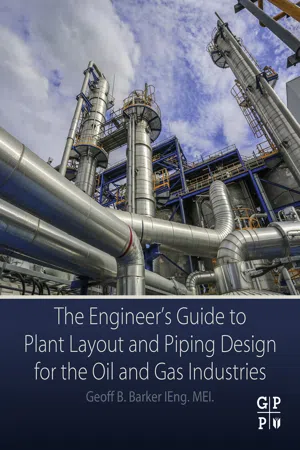
The Engineer's Guide to Plant Layout and Piping Design for the Oil and Gas Industries
- 532 pages
- English
- ePUB (mobile friendly)
- Available on iOS & Android
The Engineer's Guide to Plant Layout and Piping Design for the Oil and Gas Industries
About this book
The Engineer's Guide to Plant Layout and Piping Design for the Oil and Gas Industries gives pipeline engineers and plant managers a critical real-world reference to design, manage, and implement safe and effective plants and piping systems for today's operations. This book fills a training void with complete and practical understanding of the requirements and procedures for producing a safe, economical, operable and maintainable process facility. Easy to understand for the novice, this guide includes critical standards, newer designs, practical checklists and rules of thumb.Due to a lack of structured training in academic and technical institutions, engineers and pipe designers today may understand various computer software programs but lack the fundamental understanding and implementation of how to lay out process plants and run piping correctly in the oil and gas industry. Starting with basic terms, codes and basis for selection, the book focuses on each piece of equipment, such as pumps, towers, underground piping, pipe sizes and supports, then goes on to cover piping stress analysis and the daily needed calculations to use on the job.- Delivers a practical guide to pipe supports, structures and hangers available in one go-to source- Includes information on stress analysis basics, quick checks, pipe sizing and pressure drop- Ensures compliance with the latest piping and plant layout codes and complies with worldwide risk management legislation and HSE- Focuses on each piece of equipment, such as pumps, towers, underground piping, pipe sizes and supports- Covers piping stress analysis and the daily needed calculations to use on the job
Frequently asked questions
- Essential is ideal for learners and professionals who enjoy exploring a wide range of subjects. Access the Essential Library with 800,000+ trusted titles and best-sellers across business, personal growth, and the humanities. Includes unlimited reading time and Standard Read Aloud voice.
- Complete: Perfect for advanced learners and researchers needing full, unrestricted access. Unlock 1.4M+ books across hundreds of subjects, including academic and specialized titles. The Complete Plan also includes advanced features like Premium Read Aloud and Research Assistant.
Please note we cannot support devices running on iOS 13 and Android 7 or earlier. Learn more about using the app.
Information
Engineers and designers—Career paths—Institutes
Abstract
Keywords
1.1 What is a Piping/Plant Layout Designer and Engineer
Engineer
Designer
Engineers
Designers


1.2 Engineering Institutions and Engineering Societies
American Society of Mechanical Engineers (ASME)
The Institution of Plant Engineers (IPlantE), the Society of Operations Engineers (SOE)
Table of contents
- Cover image
- Title page
- Table of Contents
- Copyright
- Dedication
- About the Author
- Introduction
- Chapter 1: Engineers and designers—Career paths—Institutes
- Chapter 2: Piping material, process terms, and piping codes
- Chapter 3: Fundamentals of plant layout design—Plot plans
- Chapter 4: Piping and equipment basis for selection
- Chapter 5: Vessels and drums
- Chapter 6: Exchangers
- Chapter 7: Pumps
- Chapter 8: Compressors
- Chapter 9: Furnaces
- Chapter 10: Reactors
- Chapter 11: Towers
- Chapter 12: Pipe racks/structures
- Chapter 13: Underground piping
- Chapter 14: Instrumentation
- Chapter 15: Storage tanks
- Chapter 16: Utility stations, steam and condensate piping
- Chapter 17: Pipe supports selection, anchors—guides
- Chapter 18: Pipe sizing and pressure drop calculations
- Chapter 19: Pipe stress analysis and layout of hot and cold piping
- Index